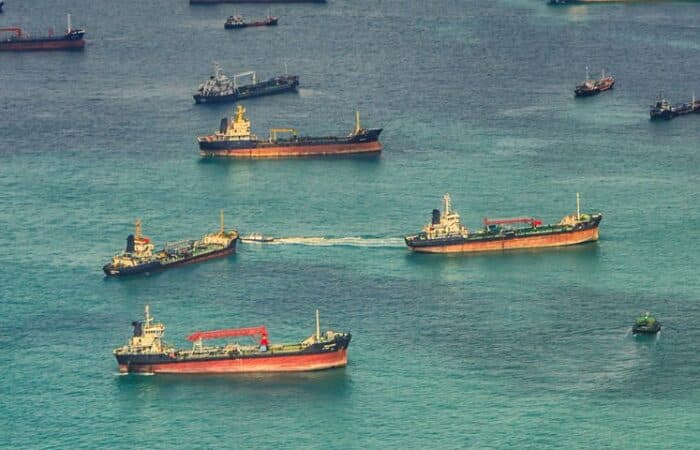Bunkering
What is Bunkering?
Bunkering refers to the process of supplying fuel to ships, while a bunker refers to fuel and oil. This fuel is used to run machinery on board the vessel and to power the engines that propel the ship across the ocean. Bunkering can be performed both onshore and offshore. Bunkering is often necessary during a vessel’s journey from port to port, as ships cannot hold enough fuel to complete long journeys.
Three Common Types of Bunkers
The three main types of bunkers commonly used in maritime operations are:
- Low sulfur fuel oil (LSFO): contains significantly reduced sulfur content to comply with strict environmental regulations to mitigate air pollution.
- High sulfur fuel oil (HSFO): contains a higher sulfur content and complies with more lenient regulations.
- Low sulfur marine gas oil (LSMGO): a cleaner-burning alternative with lower sulfur levels, suitable for use in engines that require a purer fuel source.
Each of these bunkers is used in different scenarios. Determining which bunker to use depends on factors such as regulatory requirements, engine compatibility, and environmental considerations.
Bunkering Operation Types
Bunkering can be performed at a port or offshore in a ship-to-ship (STS) operation. When executed onshore, ships receive fuel from a bunker barge, tank truck, or pipeline installation. When completed at sea, bunkering is handled by a bunker barge. In all scenarios, the fuel is pumped into the vessel through a bunker hose.

The Stages of a Bunkering Operation
Bunkering operations are split into three stages: preparation, performance, and wrap up.
Preparation
Preparation is a key stage in the process, as it sets the foundation for smooth operations. This preparation is put in place to prevent oil spills, which harm the environment and can put public health at risk.
Key elements during the preparation stage are:
- Equipment inspection: ensure that all bunkering equipment, including hoses, pumps, and meters, are in working order.
- Tank inspection: perform a rigorous check on the ship’s storage tanks to verify their integrity and suitability to receive marine fuels.
- Safety measures: check all gangway handrails and ropes, secure vertical ladders, ensure there is adequate lighting, check ladder treads and the gangway for slippery oil, and ensure that all personnel involved in bunkering have not been overworked and are not exhibiting signs of fatigue.
Performance
During this stage, fuel is bunkered into the ship. Close coordination among the bunkering team, precise control of the equipment, and strict adherence to safety procedures ensure the efficient and controlled transfer of fuel onto the ship.
Key activities during the performance stage include:
- Execution: follow the bunkering plan, which includes specific guidelines for bunkering the vessel at hand.
- Monitoring: carefully watch the process to address any unforeseen issues and maintain control over the operation.
Wrap Up
The final stage of bunkering ensures that the operation is finished, with an emphasis on safety and accuracy.
Key steps during the wrap up stage include:
- Final safety assessment: confirm all safety measures were maintained through the end of the bunkering process.
- Verification: check that the vessel received the right amount of fuel and that it aligns with the required quality standards.
- Documentation: officially conclude the bunkering operation and provide a detailed record of the process for regulatory and record-keeping purposes.
The Risks of Oil Bunkering
Oil bunkering carries risks that pose challenges to maritime safety, environmental well-being, and operational integrity.
One primary risk that occurs during ship bunkering is the potential for fuel contamination, where impurities or incompatible substances mix with the bunkered oil. Contaminated fuel can inflict severe damage on a ship’s engines, leading to operational disruptions, increased maintenance costs, and safety hazards. In 2022, bunkering fraud and “inadequate supply chain practices,” where fuel has quality discrepancies, cost shipowners $5 billion and disabled over 600 ships.
The handling of oil bunkering presents a risk of spills and leakages, whether due to equipment failure, human error, or unforeseen circumstances.
These incidents can lead to long-term environmental damage that impacts marine ecosystems and exposes the bunkering vessel to legal and financial consequences. Ensuring stringent safety measures, monitoring systems, and adherence to industry regulations are crucial to mitigating these risks associated with oil bunkering operations.
Beware of Bunkering-Related Deceptive Shipping Practices
Ship-to-ship transfers are one of the seven deceptive shipping practices (DSP) identified by the Office of Foreign Assets Control (OFAC). These transfers are used to evade sanctions by concealing the origin or destination of cargo. Some ships will engage in ship-to-ship bunkering as a cover for their deceptive practices. Maritime AI™ can expose this DSP.
In addition, bunkering accounts for 50% of a ship’s operating expenses. There are multiple schemes that bad actors participate in to take advantage of the murkiness of these transfers, including:
- Providing false information about the type or grade of bunkered fuel to take advantage of pricing differentials.
- Falsifying documents related to the quantity, quality, or origin of the bunkered fuel to deceive authorities or stakeholders.
- Diluting the bunker fuel with lower-cost substances or mixing different grades of fuel.







